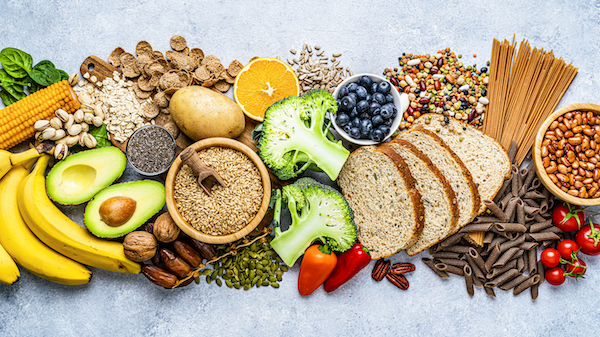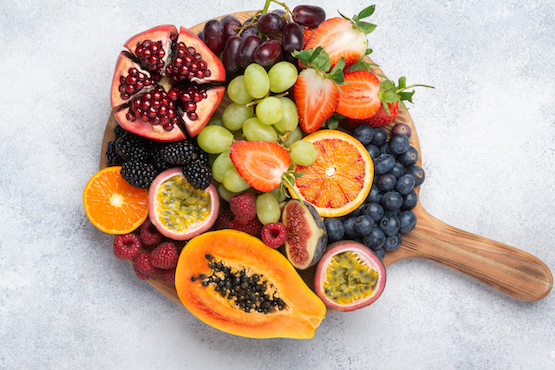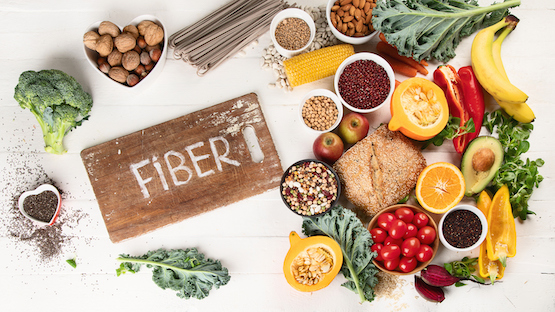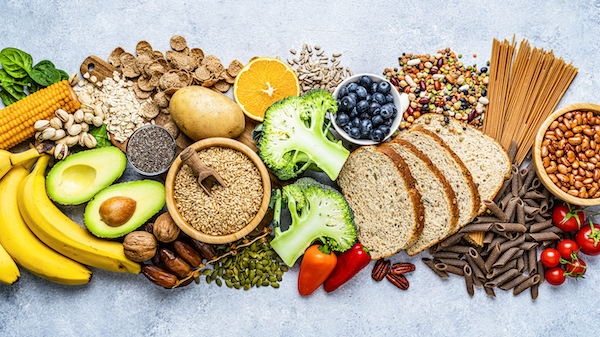It seems like everyone is talking about cutting carbs from their diets these days. But are carbohydrates really so bad for us that we should completely eradicate them from our lives? There’s a lot of confusion about carbohydrates, but it turns out carbs are not quite the enemy we’ve made them out to be.

To make informed decisions about what and how best to eat, let’s take an unbiased look at carbohydrates and how our bodies use them — and how to make smart choices with carb intake.
Here’s what you need to know about the benefits of this important macronutrient.
What are carbohydrates anyway?
Carbohydrates, protein, and fats are the three nutrients that we need in larger quantities to provide us with energy and to maintain the body’s systems. This trio of nutrients is referred to as “macronutrients.”
Carbohydrates are the body’s preferred choice for energy. When we digest carbohydrates, they are broken down into simple sugars and absorbed into the blood. We call this blood sugar, or glucose. From there glucose enters our cells with the help of the hormone insulin. All of our cells require glucose to function.
Often people think of needing carbohydrates for exercise or movement, but we also need them for our hearts to beat, our lungs to breathe and our brains to think — everything that keeps us ticking! Foods that contain carbohydrates also provide essential vitamins, minerals and fiber needed by every system in our bodies.
So, are carbs good or bad?
Black and white thinking about carbohydrates just doesn’t work. The truth about carbohydrates lies in understanding what they are and how our bodies use them. And this starts with the simple truth that…
All carbohydrates are not created equal
There are different types of carbohydrates and they all work a little differently in the body:
Simple carbohydrates
Simple carbohydrates are made of a short molecule chain. They are digested quickly and provide an immediate boost of energy to the body in the form of glucose. We find simple carbohydrates in our food in two forms:
- Naturally occuring sugars found in milk or whole fruit that co-occur with the food’s essential vitamins, minerals and fiber.

- Added sugars are a separate ingredient added to processed foods as a way to inject sweetness into what may otherwise be a flavorless mash of fillers and artificial ingredients. Often lots of added sugars are needed to make these foods palatable! Foods with added sugars are typically not balanced with naturally occurring vitamins, minerals or fiber. Consuming too many added sugars leads to weight gain.

Complex carbohydrates
Complex carbohydrates are made of longer, more complex chains of sugar molecules. They include whole grains, peas and beans, and fruits and vegetables. They take longer to digest providing a slower release of glucose because they contain fiber and are therefore a more stable source of energy than simple carbohydrates. They also contain vital nutrients.
We can find complex carbohydrates in our food in two forms:
- Unrefined or minimally processed plant foods include peas and beans, and fruits and vegetables as well as whole grains like quinoa, farro, barley, whole wheat pasta, and brown rice. These complex carbohydrates give us the fiber and nutrients we need. Special note about fruit: whole fruit contains both simple carbs and complex carbohydrates (from fiber).
- Refined carbohydrates are grains that have been processed to remove the bran and the germ. This processing also removes the fiber, healthy fats and other nutrients including B vitamins and iron. Refined carbohydrates include most breads, pastas, chips, sweets and baked goods. Consuming too many refined carbohydrates pumps too much glucose into the blood and can lead to insulin resistance and weight gain.
One reason carbs get such a bad rap is that many foods we think of as carbs like pasta, bread, cakes and cookies are refined or simple carbs without any nutrients or fiber. They are high in calories and energy, but low in nutrition.
While eating high calorie, low nutrient foods will lead to weight gain, eating plenty of unrefined or minimally processed complex carbohydrates and some naturally occurring simple carbohydrates provides us with the nutrients our body needs to fuel our brains and bodies.
The power of fiber
Complex carbohydrates contain fiber, the component of plant-based food that doesn’t get broken down or digested.
Fiber helps to keep blood sugar stable. It helps control cholesterol levels and is essential for digestive health. It also helps with satiety, the feeling of being full longer as it slows down digestion of food. This slowing down not only keeps us feeling fuller longer, it also allows our system to absorb more nutrients including vitamins and minerals.

Fiber feeds the good bacteria in the gut possibly leading to reduced inflammation and improved immunity. The impact fiber has on the gut microbiome is not yet fully understood, but researchers believe that there is a link to improved mood as well.
Eat a variety of fiber
- Soluble fiber refers to fiber that dissolves in water. Think about how chia seeds and oats absorb water and get jelly-like. Fruits, vegetables, and legumes all have soluble fiber.
- Insoluble fiber refers to fiber that doesn’t dissolve in water, but stays whole. Insoluble fiber aids digestion. Nuts seeds, grains, and brown rice are examples of foods with insoluble fiber.
- Resistant fiber is fiber that delays, or resists, being digested until after it passes through the small intestine. Starchy foods, barely ripe bananas, and sushi rice are examples of foods with resistant fiber.
- Prebiotic fiber refers to fiber that provides “food” for the healthy bacteria in our gut. Flaxseeds, bananas, onions and garlic, oats and apples are examples of foods that have great prebiotic fiber.
Instead of focusing solely on amount of carbohydrates, think about the type of carbs in your diet
What all of this means is that it’s important to choose your carbohydrates wisely. To do this, it may be more beneficial to think less about the amount of carbohydrates and more about the type of carbohydrates. If you are counting carbohydrates or going low-carb, make sure the carbs that do remain in your diet are as healthy for you as possible by prioritizing unprocessed/unrefined complex carbohydrates.
Reading the labels of packaged foods can help uncover the type of carbohydrates contained in the food and help us make sure we are getting the fiber and nutrients we need.
Become a label reader
A quick look at the nutrition label can show you how many grams of carbohydrates are in a serving. The carbohydrates will be broken down into sugar and fiber.
It will also show you how many grams of those are naturally occurring sugars and how many are added sugars.
Hidden sugars
Sugar alcohols may appear in foods that are labeled “sugar free” or “no sugar added” and won’t be included in the added sugar facts. This is misleading because sugar alcohols are still a form of carbohydrate which can impact blood sugar.
You’ll find these sugar alcohols in the ingredient list. Some examples of sugar alcohols are erythritol, maltitol, mannitol, sorbitol, xylitol, hydrogenated starch hydrolysates, or isomalt.
It’s important to note that while the Dietary Guidelines for Americans limit all Americans over the age of 2 to consume no more than 10% of their total calories from sugar (which could be up to 50g of sugar for a 2,000 calorie diet), the American Heart Association suggests no more than 24 grams for women.
Interestingly, when these guidelines were updated in 2020, the scientific advisory committee appointed to make them recommended that Americans consume no more than 6% of their total calories from sugar. These recommendations, however, were ignored. Researchers conducting a systematic review believe the new guidelines do not meet the criteria for trustworthy recommendations and are based on “low quality evidence.” It is becoming increasingly important for us as consumers to read labels and make informed choices.
The problem with “Net Carbs”
“Net carbs” also called “impact carbs” or “active carbs” are calculated by subtracting the grams of fiber and sugar alcohols or artificial sugar from the overall grams of carbohydrates. Because fiber and sugar alcohols are thought to have less impact on blood sugar levels, some low carb diets such as Keto, don’t count them as carbohydrates.
There are a few problems with this theory. First of all, the idea of “net carbs” doesn’t have a lot of scientific backing. It’s a term that isn’t legally defined, but is more of a marketing term invented by the food industry.
Processed and packaged foods can manipulate this system by adding fiber rich ingredients such as inulin, corn fiber or other materials to reduce the “net carb” total. These processed fibers may impact blood sugars differently than the naturally occurring fiber in, say, beans or quinoa.
Secondly, researchers haven’t fully discovered the impact of sugar alcohols on the body. In fact some artificial sweeteners with few to no calories may actually impact the body by raising blood sugar levels the same way sugar does.
Additionally, it takes a bit of mental math to figure out net carbs, a process which may be difficult to sustain over time.
All in all, focusing on “net carbs” can be misleading because it can result in people overeating calories for the sake of net carbs and under-consuming nutrient rich foods.
What About the Glycemic Index of Carbohydrates?
Glycemic index (GI) is a sort of “food rating system” for foods with carbohydrates. It is intended to show us how much and how quickly the food affects our blood sugar levels if the food is eaten on its own.
Foods with protein, fat or fiber have a lower glycemic index, while refined foods and those high in sugar have a higher glycemic index.
Foods may be rated as
- Low: 55 or less
- Medium: 56–69
- High: 70 or above
A number of factors can impact the glycemic index of foods including processing, cooking or ripeness, so it’s not the most reliable indicator.
Also, the numbers can be misleading. For example, watermelon has a GI of 72 but Pillsbury Chocolate Chip Cookie Refrigerated Dough has a GI below 55. Which food is the healthier choice?
While understanding glycemic index of foods can be helpful to some with diabetes, or to help control blood glucose, relying on glycemic index alone is not a great way to manage weight or nutrition.
Who might benefit from eating more healthy carbohydrates?
Focusing on getting plenty of fiber from whole foods is a powerful weight loss and health tool. Though the general recommendation for women is to consume 21-25 g of fiber daily, the American Heart Association recommends 25-30g a day.
Unfortunately, in our standard American diet, most of us are not consuming nearly enough. The average American woman is only consuming about 15g of fiber a day.
Christine, a 55-year-old woman, had been following a strict low carb diet for several years, but still couldn’t lose the 25 pounds her doctor recommended.
It seemed like she was doing everything right. Her diet focused on whole foods. She was fasting intermittently and avoiding both gluten and processed foods. Christine was even exercising nearly every day of the week, participating in a local Zumba class and a strength training program.
When she finally assessed her fiber intake, she realized that she was only eating about 8g of fiber each day, dramatically under the daily recommendation. It was hard, at first, to recognize that she needed to embrace carbohydrates after years of avoiding them, but once she began to incorporate whole grains, beans and legumes, the pounds began to go.
Sometimes it’s less about restriction, and more about adding in more nutrients.
You may benefit from adding in more healthy carbohydrates if you are
- physically active
- pregnant or breastfeeding
- struggling to either lose or gain weight
- want some more freedom and flexibility around eating
How to increase fiber
- Add ½ cup of beans to meals
- Eat the skins of fruits and vegetables whenever possible
- Eat whole fruit instead of drinking the juice
- Swap quick cook oats for rolled or whole oats
- Enjoy a slice of avocado on a sandwich instead of mayonnaise
- Incorporate plenty of beans and legumes such as lentils, kidney beans, split peas in soups and stews
- Try a handful of raspberries for a whopping 8g of fiber
- Instead of snacking on chips, try some air popped popcorn
Go slowly in order to avoid any uncomfortable gas or bloating that may occur as your body gets used to increased fiber consumption. Up your intake by about 5g/day.
Be sure to drink plenty of water. Fiber requires water to be digested properly. It absorbs water in the intestines which bulks up stool. Drinking plenty of water helps to avoid constipation, gas, and bloating.

Who might still benefit from a low carb style of eating?
There are still some people who may certainly benefit from following a diet low in carbohydrates. If you have a concern, speak to your doctor who may recommend a nutritionist to best support your dietary needs.
You might still benefit from a low carb style of eating if you are
- sedentary
- diagnosed with epilepsy, PCOS, yeast overgrowth, insulin resistance, type 1 or 2 diabetes
- Have a neurodegenerative disorder, such as Parkinsons or Alzheimer’s
- have certain forms of cancer
Transform your relationship with carbs
It may be time to rethink our relationship with carbohydrates. Start your journey to a more balanced approach to eating. Focusing on getting plenty of fiber rich foods from whole food plant sources is a simple start to improving overall health and well-being.
 | Concerned about insulin resistance and diabetes? Learn 4 ways to naturally balance your blood sugar. |
Sources
The Scientific Basis of Guideline Recommendations on Sugar Intake: A Systematic Review
Scientific Advisory Committee Report
Dietary Guidelines for Americans
Fiber and mood
A recent study showed longer lifespan is greatest in people consuming 50-55% carbohydrates.











